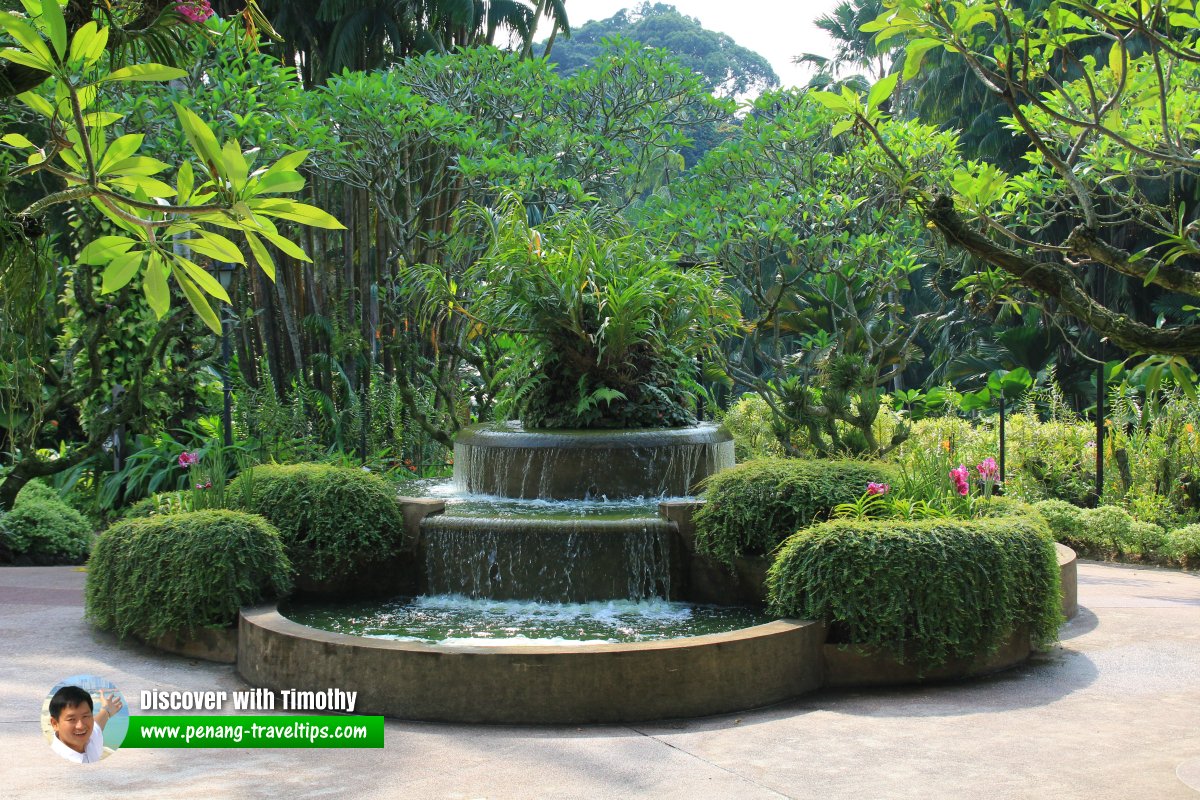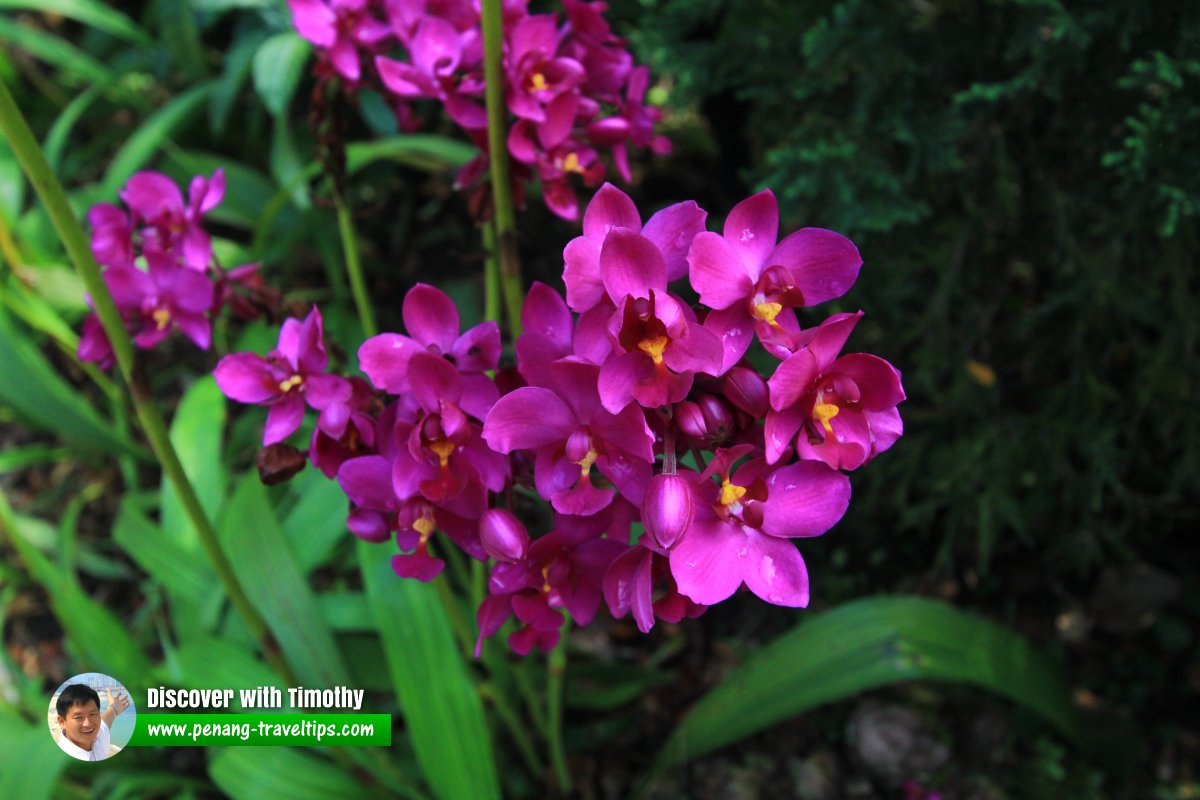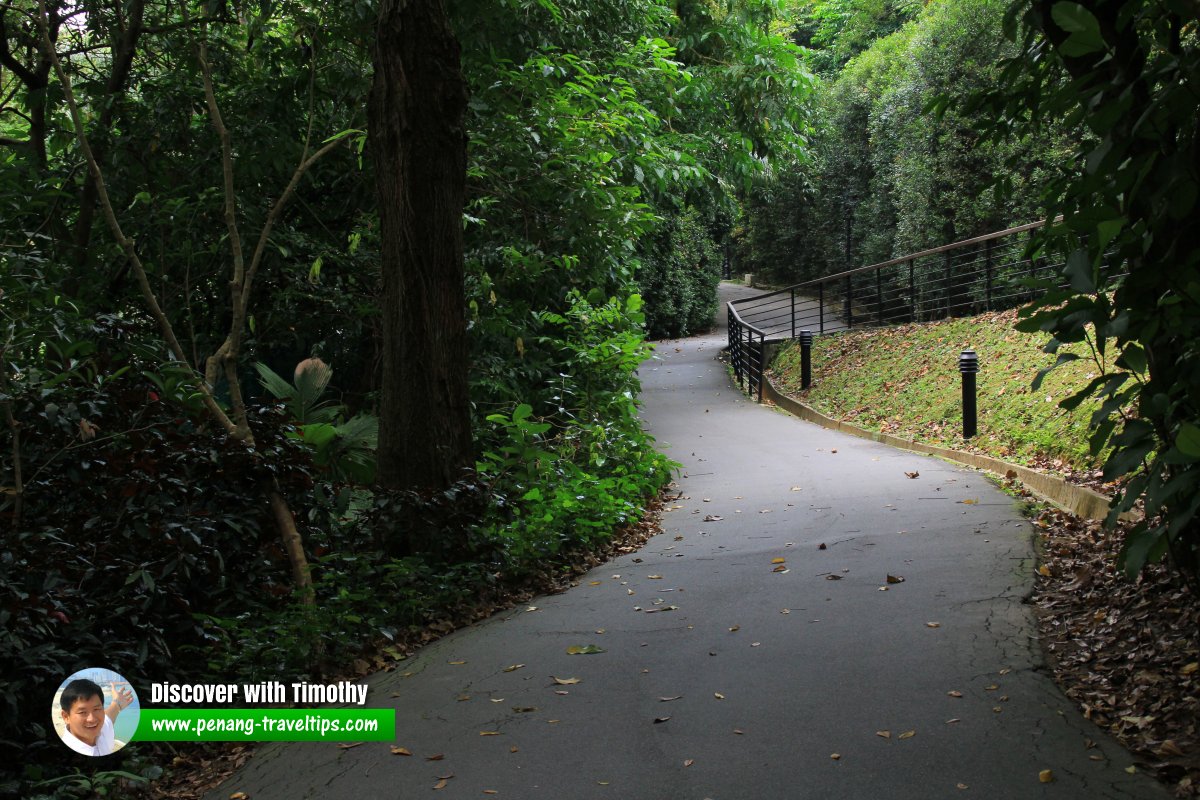 Singapore Botanic Gardens, at Bukit Timah Gate (2 August 2017)
Singapore Botanic Gardens, at Bukit Timah Gate (2 August 2017)
Singapore Botanic Gardens (GPS Tanglin Gate: 1.3079, 103.81855, Bukit Timah Gate: 1.32267, 103.81473) is a botanic garden in Tanglin, Singapore. It is one of the most important botanic gardens in Southeast Asia. It covers 63.7 hectares (157 acres) of land close to the Orchard Road area. The botanic gardens is half the size of the Royal Botanic Gardens in Kew and one-fifth the size of New York City's Central Park. It was inscribed as a World Heritage Site by UNESCO on 4 July, 2015, becoming the only tropical botanic garden to be so recognised, and one of only three botanic gardens which are World Heritage Sites.
Layout of the Singapore Botanic Gardens
To make it easier for visitors to find their way through the gardens, it is divided into three main sections namely Tanglin Core, Central Core and Bukit Timah Core. Within the Tanglin Core, you find the Tanglin Gate, Swan Lake and Bonsai Garden. At the Central Core, you find the Visitor Centre, National Orchid Garden, Palm Valley, Rain Forest and Evolution Garden. At the Bukit Timah Core, you find the Garden of Spices, the Bamboo Garden, Eco Lake, Fruit Trees and Jacob Ballas Children's Garden.History of the Singapore Botanic Gardens
The Singapore Botanic Gardens can trace its beginning right up to the founding of Singapore itself. Sir Stamford Raffles himself established a "Botanical and Experimental Garden" in Singapore in 1822 on Government Hill at Fort Canning. The purpose of that garden was to find and develop plants that can be used as commercial crops. However, due to insufficient funds, and there being no full-time director to lead it, the garden died a slow death, neglected and eventually closed after Raffles passed away in 1829. Orchids, Singapore Botanic Gardens (9 July 2011)
Orchids, Singapore Botanic Gardens (9 July 2011)
In 1859, the Agri-Horticultural Society founded its own gardens on the site of the present Singapore Botanic Gardens. The land was acquired from Chinese merchant Hoo Ah Kay @ Whampoa, who in return was given land at Boat Quay. Until then, Whampoa had used it as a plantation. The society developed their Gardens for recreational activities. Laurence Niven, its superintendent and landscape designer, cleared the plantation and turned it into an ornamental park, the layout of it today is still very much faithful to Niven's design. The Gardens was used by the Society for flower shows and horticultural fetes. They maintained it until 1874, when they ran out of funds to maintain it, and handed it over to the government.
In the hands of the government, the role of the Singapore Botanic Gardens reverted to continue the mission of developing commercial crops. Botanists and Horticulturists trained at Kew were employed to manage the Gardens. Its first Director of the Singapore Botanic Gardens was Henry Ridley, the man credited with introducing the planting of rubber in Malaya. He started working at the Gardens in 1888, and for the next 23 years, worked tirelessly not only to persuade plantation owners to try rubber, but also to ways to tap the trees without damaging them. Planters nicknamed him Mad Ridley, and largely ignored his plea, until their coffee crops were brought down by diseases, and they desperately needed a new cash crop.
The planting of rubber coincided with the automobile industry boom, and through Ridley's efforts, the Singapore Botanic Gardens was responsible for the fortune of not only Malaya, but much of Southeast Asia.
 Fountain at the National Orchid Garden, Singapore (9 July 2011)
Fountain at the National Orchid Garden, Singapore (9 July 2011)
During Ridley's administration, an Armenian lady named Agnes Joachim discovered a hybrid orchid in her garden. She showed it to Ridley. That orchid, Vanda Miss Joachim, is today regarded as the National Flower of Singapore.
Singapore's orchid industry was largely the effort of Professor Eric Holttum, the Director of the Singapore Botanic Gardens from 1925-1949. Prof Holtum set up laboratories to conduct experiments on orchid breeding and hybridization.
The role of the Singapore Botanic Gardens continue to evolve over the decades. In the 1960s, it was given responsibility in greening Singapore. The Gardens supplied planting material for road sides and parks. The management of the Gardens evolved with the time as well. In 1973, it became part of the Parks and Recreation Department. In 1990, it fell under the management of National Parks Singapore, with Dr Tan Wee Kiat as the Chief Executive Officer. Under Dr Tan, the National Orchid Garden was established. Today it is one of the major highlights of the Singapore Botanic Gardens.
 Spathoglottis orchids, National Orchid Garden, Singapore (9 July 2011)
Spathoglottis orchids, National Orchid Garden, Singapore (9 July 2011)
Admission to the Singapore Botanic Gardens is free, except for the National Orchid Garden, which charges a fee of S$5.00 for adults. The Singapore Botanic Gardens is the only botanic gardens with an opening hour from 5:00am in the morning until 12 midnight every day. There are a few entrances to the Gardens including Tanglin Gate (the main entrance), Burkill Gate, Nassim Gate and Cluny Park Gate. There is a taxi drop-off point at the Visitor Centre along Cluny Road.
Getting there
If you are going to the Singapore Botanic Gardens by taxi or private car, enter the gardens at Nassim Gate, at the heart of the gardens. This takes you directly to the Visitor Centre, from where you can decide whether to explore the northern or southern part of the gardens. Red Frangipani, Singapore Botanic Gardens (9 July 2011)
Red Frangipani, Singapore Botanic Gardens (9 July 2011)
At present, the nearest MRT station is the Orchard MRT Station, which will require a walk of half an hour along Orchard Road, Tanglin Road and Napier Road. A promenade is built along the route to make the journey easier. The first sight of the Singapore Botanic Gardens on this route is Tanglin Gate.
In future, there will be a new Botanic Gardens MRT Station located off Bukit Timah Road, on the northern end of the gardens. It will allow you to enter the gardens directly. The station will be served by the Circle Line and later by the Downtown Line.
 Forested path at the Singapore Botanic Gardens (9 July 2011)
Forested path at the Singapore Botanic Gardens (9 July 2011)
Areas of Improvement for the Singapore Botanic Gardens
Although the Singapore Botanic Gardens is one of the best botanic gardens in the region, there are some areas which it can still improve. As a garden in Southeast Asia, it has a good selection of spices and fruit trees.However, it would be fantastic if the gardens can create actual paddy fields, rubber plantations, palm oil plantations, to name some of the major plantations found in the region. This will provide visitors a glimpse of the commodity crops that are planted in Southeast Asia, as the majority of visitors do not get to go near to paddy fields and plantations. While not available at the Singapore Botanic Gardens, you can however view rubber trees, palm oil and other crops in the mini plantation of the Ecogarden, at the Science Centre, Singapore.Singapore Botanic Gardens on Google Street View
Tanglin Gate, Singapore Botanic Gardens (Jun 2019)Features of the Singapore Botanic Gardens
Sights at the Singapore Botanic Gardens
Lakes at the GardenNational Orchid Garden
Singapore Botanic Gardens is  on the Map of Tanglin, Singapore
on the Map of Tanglin, Singapore
Singapore Botanic Gardens is  on the Map of Parks in Singapore
on the Map of Parks in Singapore
List of the Parks in Singapore; Discover Singapore
 Copyright © 2003-2025 Timothy Tye. All Rights Reserved.
Copyright © 2003-2025 Timothy Tye. All Rights Reserved.
Copyright © 2003-2025 Timothy Tye. All Rights Reserved.

 Go Back
Go Back